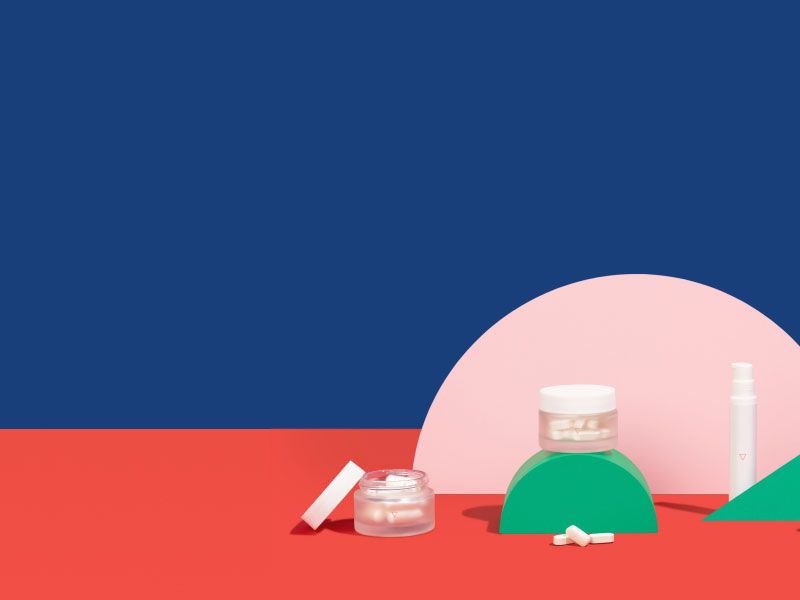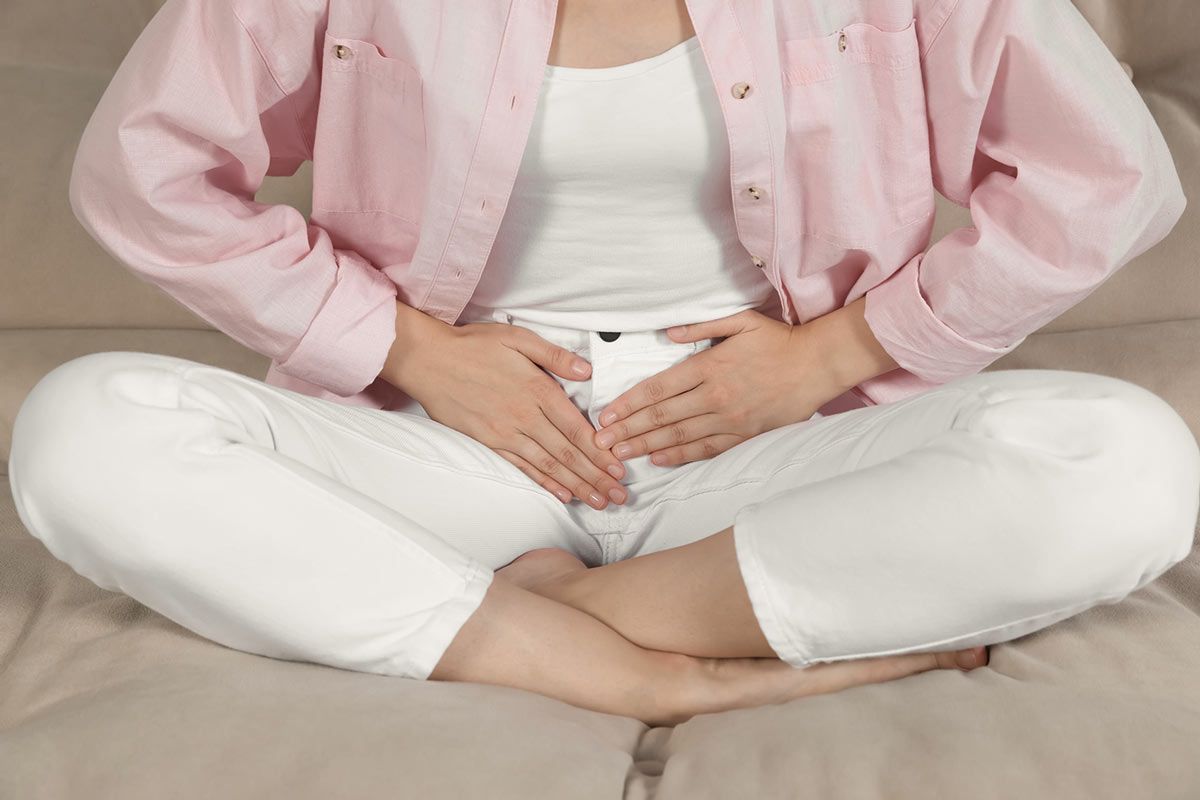
Signs of BV (Bacterial Vaginosis)
and How to Address Them
Published on
February 12, 2025
Updated on December 4, 2025
Written by Kathleen Morrison
Medically Reviewed by Andrea Sleeth WHNP-BC, MSCP
Key takeaways:
- BV happens when the natural balance of vaginal bacteria shifts, often leading to discharge, odor, or mild irritation.
- While not an STI, sexual activity, douching, and scented products can increase the risk of developing BV.
- Getting a proper diagnosis—whether at home or with a provider—helps ensure you treat the root cause, not just the symptoms.
- Antibiotics are the most common treatment, but gentle hygiene habits and probiotics can help support vaginal health in the long term.
- Supporting vaginal health means avoiding harsh cleansers, wearing breathable fabrics, and seeking care early if symptoms return.
Recognizing the signs of BV (Bacterial Vaginosis) can sometimes feel tricky, especially since its symptoms can be mistaken for other issues. This confusion is common, but you’re not alone—we’re here to help.
BV happens when the natural balance of bacteria in your vagina gets a little out of sync. While it’s not a sexually transmitted infection (STI), it can still cause stress if left unaddressed. Symptoms like unusual discharge, a "fishy" odor, or itchiness can feel overwhelming, but the good news is that BV is treatable with the proper care.
By knowing what to look for and seeking prescription and over-the-counter treatment like BV antibiotics early, you can take control of your vaginal health and avoid potential complications.
What is Bacterial Vaginosis?
Bacterial Vaginosis (BV) is super common, and it happens when the natural balance of bacteria in your vagina shifts. This can sometimes cause uncomfortable symptoms—like unusual discharge or a noticeable vaginal odor—but not everyone experiences clear signs right away.
Here’s the thing: BV isn’t an STI, but factors like sexual activity, hormonal changes, and even certain hygiene habits can play a role in its development. Knowing why you might develop BV and how it shows up is the first step to taking charge of your vaginal health.
BV is one of the most common vaginal infections for people of reproductive age, and it’s nothing to feel embarrassed about. If you’re experiencing symptoms or just want peace of mind, it’s easy to connect with providers and get the care you need—fast, discreet, and on your terms.
Common Symptoms of Bacterial Vaginosis
It’s not always easy to recognize the signs of Bacterial Vaginosis (BV), especially since the symptoms can initially be subtle. Common signs to watch for include:
- Discharge: Thin, white, or gray discharge that looks different from your usual patterns.
- Odor: A fishy smell, often more noticeable after sex.
- Mild discomfort: Some people experience mild vaginal itching or burning, though this isn’t always present.
These changes occur when the natural bacterial balance in your vagina shifts. Normally, lactobacilli help maintain a healthy, acidic environment. When their levels drop, other bacteria can take over, leading to odors, unusual discharge, or discomfort.
Because BV symptoms can overlap with other vaginal issues, it’s easy to confuse them. Here are some tips for monitoring your vaginal health:
- Watch for key differences: A fishy odor is often a telltale sign of BV, especially if it intensifies after intercourse. But this could also signal something like trich, so testing (no matter your symptoms) is always the right move.
- Track changes: Pay attention to shifts in the color, consistency, and scent of your discharge.
- Be proactive: If you notice unfamiliar symptoms, reaching out to a medical provider early can save you time, stress, and potential complications.
Causes and risk factors of BV
It’s natural to wonder why BV happens and what might increase your chances of experiencing it. You develop bacterial vaginosis when the balance of bacteria in the vagina shifts, reducing the protective lactobacilli that help maintain a healthy environment. While this imbalance can feel frustrating, understanding common triggers can empower you to make choices that support your vaginal health.
What causes BV?
BV occurs when bacteria that thrive in less acidic conditions outgrow the helpful lactobacilli in your vagina. Here's how this balance can be disrupted:
- Douching or scented products: These can upset your vaginal environment, making it easier for unwanted vaginal bacteria to take over.
- Sexual activity: While BV isn’t classified as an STI, introducing new bacterial strains through unprotected sex or changing partners can disrupt the balance.
- Overwashing or harsh chemicals: Too much cleansing or using harsh products (such as vaginal deodorants) can strip away the natural bacteria that keep your vagina healthy.
It’s important to remember that BV isn’t caused by poor hygiene. In fact, overwashing can do more harm than good. Stick to gentle cleansers and water to maintain your natural balance.
Who is at risk for BV?
BV can affect anyone with a vagina, but certain factors may increase the likelihood:
- Sexually active: Engaging in unprotected sex or having multiple sex partners can introduce new bacteria and may raise the chance of BV.
- Pregnancy: Hormonal shifts during pregnancy can alter vaginal pH, making BV more likely.
- Hygiene practices: Douching or using heavily scented soaps and sprays can irritate tissues and disrupt your vaginal ecosystem.
- Smoking: Smoking may impact your body’s ability to maintain a healthy balance of bacteria.
- Chronic conditions or weakened immune system: These factors can make it harder for your body to keep unwanted bacteria in check.
- Stress and lifestyle: High stress, poor sleep, and unbalanced eating habits can also contribute to disruptions in your vaginal health.
What you can do
BV doesn’t discriminate—it can happen to anyone. By identifying potential triggers or risk factors, you can take steps to support your vaginal health:
- Avoid douching and scented products.
- Always use condoms and keep any sex toys you use clean to reduce any bacterial disruptions.
- Talk to a healthcare provider about any lifestyle habits that might affect your vaginal balance.
- If you’re experiencing symptoms, don’t hesitate to seek care—it’s not about hygiene; it’s about balance.
Diagnosing BV
If you’re experiencing symptoms like unusual discharge, itching, or general vaginal irritation, figuring out if BV is the cause is the first step toward feeling better. Since many vaginal conditions share overlapping signs, an accurate diagnosis helps pinpoint the issue so you can get the care you need. Chatting with a healthcare provider and using simple tests can confirm whether BV is the source of your symptoms.
How is BV diagnosed?
Diagnosing BV is usually quick and straightforward. During a pelvic exam, your provider will check for any unusual vaginal discharge, collect a small sample of vaginal fluid, and use the sample to look for “clue cells”—vaginal cells coated with bacteria.
They may also test the vaginal pH since BV often raises it above the normal range. A quick test may be performed to detect a fishy odor when the sample is combined with a specific solution.
Healthcare providers often rely on a set of criteria called Amsel’s guidelines to diagnose BV.
These include:
- Elevated vaginal pH
- The presence of clue cells
- A thin, homogeneous discharge
- A distinctive fishy odor, sussed out with a “whiff test” (yes, that’s really what it’s called)
Some clinics also offer quick tests that detect enzymes linked to BV. While the process sounds clinical, most methods are simple, painless, and highly effective.
Can you test for BV at home?
Absolutely! If you prefer a more private option, at-home BV testing kits let you collect a sample yourself and send it to a lab for analysis. Once your results are ready, a licensed healthcare professional will guide you on the next steps, like treatment or lifestyle tweaks, to keep your vaginal health on track.
How to test for BV at home
If you’ve decided to test for BV at home, here’s what to expect. Most at-home BV tests come with an easy-to-use kit that lets you collect a small sample of vaginal discharge using a sterile swab. You’ll follow the included instructions to either:
- Test your vaginal pH at home—some kits include a pH strip that changes color if your levels are higher than normal (a common sign of BV).
- Send your sample to a lab—other kits include a prepaid mailer so you can send your swab to a certified lab for professional analysis.
Once your results are ready, you’ll get a clear report—often within a few days—showing whether BV bacteria are present. Many services also include a virtual follow-up with a licensed healthcare provider who can confirm your results and prescribe treatment (like metronidazole) if needed.
Testing at home is quick, private, and discreet—perfect if you’d rather skip the in-person waiting room but still want accurate results and real medical guidance.
Why a proper diagnosis matters
BV symptoms can sometimes feel similar to other conditions, like a vaginal yeast infection or trichomoniasis. That’s why getting the proper diagnosis is key—it ensures you’re treating the actual cause of your symptoms instead of guessing.
Once BV is confirmed, your provider can recommend the right medication or suggest lifestyle adjustments to restore balance and help you feel confident again.
Management and treatment for Bacterial Vaginosis
Treating BV is usually straightforward, involving antibiotics to tackle the bacterial imbalance. But treatment is just one part of the equation. Incorporating simple self-care strategies and making small changes to your daily routine can support healing and reduce the chances of BV coming back.
The goal is to focus on balancing the bacteria in your vagina, and sometimes a mix of medicine and self-treatment in the form of lifestyle adjustments works best.
Medical treatments for BV
Most treatments for BV involve prescription antibiotics, which target the harmful bacteria while allowing healthy lactobacilli (good bacteria) to grow back. Common options include oral antibiotics like metronidazole for BV or tinidazole, or intravaginal treatments like clindamycin cream. These treatments typically last several days, and it's important to follow the full course, even if your symptoms improve early. Stopping early can cause the bacteria to bounce back.
You might experience mild side effects from oral antibiotics, such as an upset stomach or a metallic taste. If that happens, ask your healthcare provider for tips on easing those effects, like taking the meds with food. If oral antibiotics aren't for you, there are intravaginal treatments that can be an alternative, like instant itch relief cream for BV.
During treatment, your healthcare provider may recommend avoiding sexual activity until you’ve completed your antibiotics to help mitigate further irritation or bacterial disruption.
If BV keeps coming back, your provider may offer a longer treatment plan or switch to a different antibiotic. It’s also a good time to chat about what might be triggering your BV, like your sexual habits or hygiene routine. In some cases, a probiotic designed specifically for vaginal health might be suggested.
Luckily, there’s a whole range of prescription, OTC, and even supplement options to fit your needs, discreetly and comfortably—check them out if you feel you may need intervention.
Wisp treatment options are available only after consultation with a licensed medical professional. You should consult with your healthcare provider before starting a new supplement or treatment regimen. Individual results may vary.
These statements have not been evaluated by the Food and Drug Administration. This product is not intended to diagnose, treat, cure, or prevent any disease.
Lifestyle changes to manage BV
Small changes to your daily habits can also go a long way in helping lower future BV flare-ups and supporting your body. Here are a few simple tips that can make a big difference:
- Skip the douching: It may seem like a good way to cleanse, but oftentimes, douching upsets your balance by removing the beneficial bacteria that keep your vagina healthy.
- Use mild, fragrance-free soaps: Stick to gentle, unscented soaps for cleaning your external genital area to maintain the natural balance of your vaginal flora. Strong or perfumed products can disrupt the pH.
- Probiotics can help: Some people find that taking probiotics—whether as capsules or vaginal suppositories—helps maintain that balance after antibiotic treatment. While research is still ongoing, many find probiotics can be a helpful part of their recovery routine. Always check with your healthcare provider for recommendations on the best options for you.
- Wear breathable clothing: Cotton underwear and quick changes out of damp clothes can help keep moisture buildup at bay and reduce bacterial growth.
- Consider pausing sexual activity: If you experience frequent BV episodes, introducing condoms if you’re not already using them, or taking a break from sexual activity may help lower the chances of the introduction of new bacteria that could disrupt the vaginal environment.
Taking control of your sexual health with early action
Recognizing the early signs of BV is key to getting treatment and feeling better faster. It helps ease discomfort and lowers the chances of complications down the road. Keep an eye on changes in discharge, odor, or any irritation—these are great starting points for identifying BV early.
Taking care of your vagina, making mindful choices during sexual activity, and reaching out to a healthcare provider when something feels off are all important steps in managing BV. At Wisp, we make it easier for you to take control of your sexual health with discreet, hassle-free services. You deserve to make informed decisions about your well-being—without the stress of traditional medical settings.
For personalized support, check out our symptoms quiz or browse our BV prescription and OTC treatments. Show BV who's boss.
This blog post is for informational and educational purposes only and should not be taken as professional advice. Always consult with a qualified professional before making any decisions based on the information provided here.
Trusted Treatments

BV Antibiotics (Tablets or Gel)
Starting at $15
Request topical or oral prescription antibiotics to treat bacterial vaginosis.

Vaginitis Test
$159
Test for the 10 most common disruptive microbes from the comfort of home with one swab.


